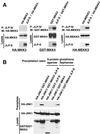JLP: A scaffolding protein that tethers JNK/p38MAPK signaling modules and transcription factors
- PMID: 12391307
- PMCID: PMC137859
- DOI: 10.1073/pnas.232310199
JLP: A scaffolding protein that tethers JNK/p38MAPK signaling modules and transcription factors
Abstract
Extracellular signals are transduced into cells through mitogen-activated protein kinases (MAPKs), which are activated by their upstream kinases. Recently, families of scaffolding proteins have been identified to tether specific combinations of these kinases along specific signaling pathways. Here we describe a protein, JLP (c-Jun NH2-terminal kinase-associated leucine zipper protein), which acts as a scaffolding protein to bring together Max and c-Myc along with JNK (c-Jun NH2-terminal kinase) and p38MAPK, as well as their upstream kinases MKK4 (MAPK kinase 4) and MEKK3 (MAPK kinase kinase 3). Thus, JLP defines a family of scaffolding proteins that bring MAPKs and their target transcription factors together for the execution of specific signaling pathways.
Figures





Similar articles
-
Early modifications in the expression of mitogen-activated protein kinase (MAPK/ERK), stress-activated kinases SAPK/JNK and p38, and their phosphorylated substrates following focal cerebral ischemia.Acta Neuropathol. 2003 May;105(5):425-37. doi: 10.1007/s00401-002-0661-2. Epub 2003 Jan 21. Acta Neuropathol. 2003. PMID: 12677442
-
Mixed lineage kinase-dependent JNK activation is governed by interactions of scaffold protein JIP with MAPK module components.EMBO J. 2001 Jul 2;20(13):3447-58. doi: 10.1093/emboj/20.13.3447. EMBO J. 2001. PMID: 11432832 Free PMC article.
-
JSAP1, a novel jun N-terminal protein kinase (JNK)-binding protein that functions as a Scaffold factor in the JNK signaling pathway.Mol Cell Biol. 1999 Nov;19(11):7539-48. doi: 10.1128/MCB.19.11.7539. Mol Cell Biol. 1999. PMID: 10523642 Free PMC article.
-
Calcineurin-NFAT signaling regulates the cardiac hypertrophic response in coordination with the MAPKs.Cardiovasc Res. 2004 Aug 15;63(3):467-75. doi: 10.1016/j.cardiores.2004.01.021. Cardiovasc Res. 2004. PMID: 15276472 Review.
-
From receptors to stress-activated MAP kinases.Oncogene. 1999 Nov 1;18(45):6087-93. doi: 10.1038/sj.onc.1203129. Oncogene. 1999. PMID: 10557099 Review.
Cited by
-
Overexpression of SPAG9 correlates with poor prognosis and tumor progression in hepatocellular carcinoma.Tumour Biol. 2014 Aug;35(8):7685-91. doi: 10.1007/s13277-014-2030-x. Epub 2014 May 8. Tumour Biol. 2014. PMID: 24801907
-
Independent pathways downstream of the Wnd/DLK MAPKKK regulate synaptic structure, axonal transport, and injury signaling.J Neurosci. 2013 Jul 31;33(31):12764-78. doi: 10.1523/JNEUROSCI.5160-12.2013. J Neurosci. 2013. PMID: 23904612 Free PMC article.
-
Scaffolding proteins in G-protein signaling.J Mol Signal. 2007 Oct 30;2:13. doi: 10.1186/1750-2187-2-13. J Mol Signal. 2007. PMID: 17971232 Free PMC article.
-
Sperm-Associated Antigen 9 Promotes Influenza A Virus-Induced Cell Death via the c-Jun N-Terminal Kinase Signaling Pathway.mBio. 2022 Jun 28;13(3):e0061522. doi: 10.1128/mbio.00615-22. Epub 2022 May 31. mBio. 2022. PMID: 35638835 Free PMC article.
-
G12 signaling through c-Jun NH2-terminal kinase promotes breast cancer cell invasion.PLoS One. 2011;6(11):e26085. doi: 10.1371/journal.pone.0026085. Epub 2011 Nov 7. PLoS One. 2011. PMID: 22087220 Free PMC article.
References
-
- Brunet A. & Pouyssegur, J. (1997) Essays Biochem. 32, 1-16. - PubMed
-
- Cano E. & Mahadevan, L. C. (1995) Trends Biochem. Sci. 20, 117-122. - PubMed
-
- Davis R. J. (1995) Mol. Reprod. Dev. 42, 459-467. - PubMed
-
- Dhanasekaran N. & Reddy, E. P. (1998) Oncogene 17, 1447-1455. - PubMed
-
- English J., Pearson, G., Wilsbacher, J., Swantek, J., Karandikar, M., Xu, S. & Cobb, M. H. (1999) Exp. Cell Res. 253, 255-270. - PubMed
Publication types
MeSH terms
Substances
Associated data
- Actions
- Actions
Grants and funding
LinkOut - more resources
Full Text Sources
Molecular Biology Databases
Research Materials
Miscellaneous

